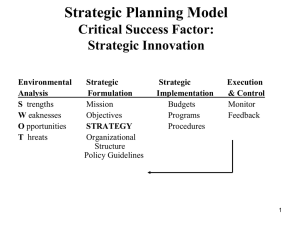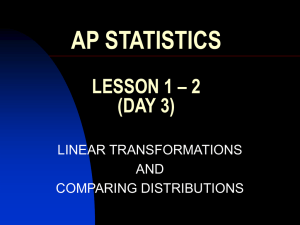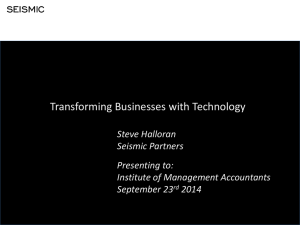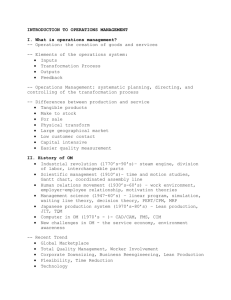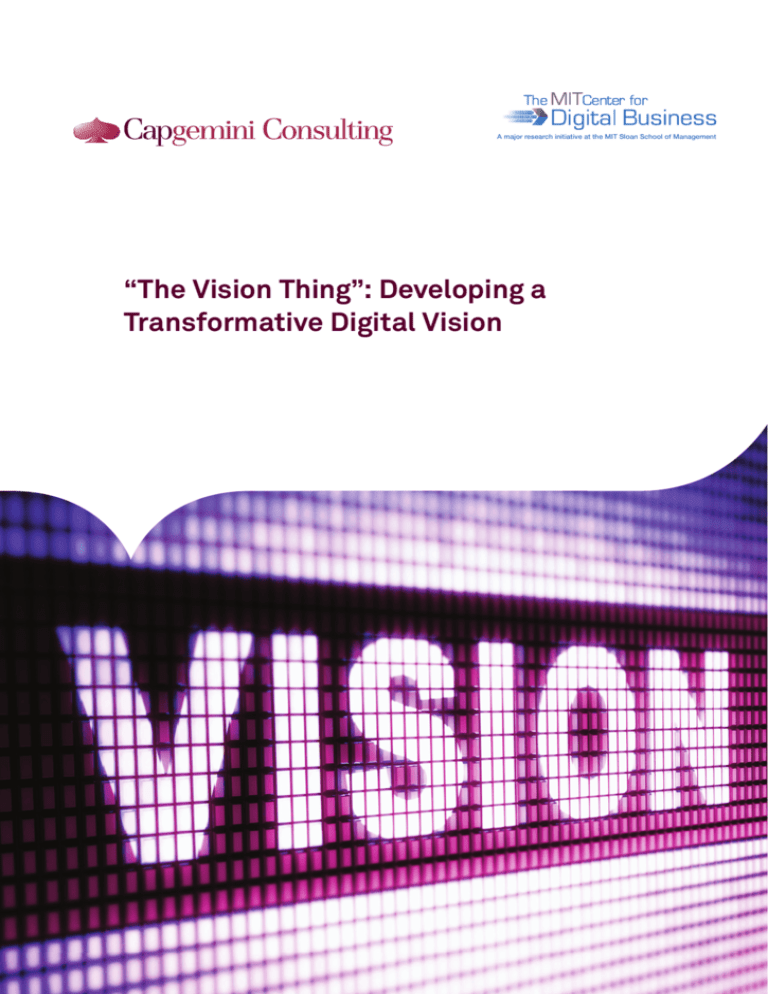
101011010010
101011010010
101011010010
A major research initiative at the MIT Sloan School of Management
“The Vision Thing”: Developing a
Transformative Digital Vision
Introduction
“We had a vision, and the vision was to
be the first company to be fully digital
end-to-end. The [resulting] experience
would be that a customer will have
access to Burberry across all devices,
anywhere in the world.”1
With this vision, CEO Angela Ahrendts
drove a digital transformation within
Burberry, a 155-year-old fashion company
and an iconic UK brand. Burberry’s
executive team used the power of digital
technologies to reinvigorate the brand,
create a consistent customer experience
on a global scale and deliver consistently
healthy financial results.
Digital technologies are having a
pervasive influence on business,
transforming the customer experience,
enhancing productivity in operations
and improving the way employees
collaborate. Yet, many organizations
fail to capture the full potential of digital
technologies because their leaders lack
a transformative vision. Executives with
an incremental vision get what they aim
2
for – incremental improvement. Those
who realize the transformative power of
digital can achieve much more.
We had a vision, and
the vision was to be the
first company to be fully
digital end to end.
- Angela Ahrendts,
CEO Burberry
A bottom-up approach does not deliver
successful
digital
transformation.
Only the top layer of a company can
create a compelling vision of the future
and communicate it throughout the
organization. Often, the real benefits
of transformation come from seeing
potential synergies across silos, and then
creating the conditions through which
everyone can begin to unlock that value.
Only senior executives are positioned to
drive this level of change.
Over the last three years, Capgemini
Consulting and the MIT Center for
Digital Business have been researching
the impact of digital technologies
on the reach and the performance
of organizations. We identified two
key dimensions for successful digital
transformation: the “What” and the
“How.” The “What” represents digital
intensity, a measure of the strength
of digital activities of an organization.
The “How” represents transformation
management intensity, a measure of
an organization’s vision, governance,
and skills. Companies that are strong
in digital intensity conduct numerous
digital initiatives, but only effective
transformation management helps them
identify and deliver digital investments
in a powerful and well-coordinated way.
We call companies that excel in both
dimensions the “Digirati” (see Figure 1).
Figure 1: Four levels of Digital Mastery
Fashionistas
Many advanced digital features (such as social,
mobile) in silos
Digital Intensity
No overarching vision
Underdeveloped coordination
Digital culture may exist in silos
Digirati
Strong overarching digital vision
Good governance
Many digital initiatives generating business
value in measurable ways
Strong digital culture
Beginners
Conservatives
Management sceptical of the business value of
advanced digital technologies
May be carrying out some experiments
Immature digital culture
Overarching digital vision exists, but may be
underdeveloped
Few advanced digital features, though traditional
digital capabilities may be mature
Strong digital governance across silos
Taking active steps to build digital skills and culture
Transformation Management Intensity
Digital intensity measures how advanced digital
initiatives are within an organization. This includes
investments in customer experience, operational
processes, business model transformation, as well
as digital capabilities.
Transformation management intensity measures
senior executives’ capability to drive change
throughout the organization. This includes creating
and communicating a clear vision, establishing
governance mechanisms, facilitating cross-silo
coordination, and building a digital-ready culture.
Source: Capgemini Consulting and MIT Center for Digital Business – “Digital Transformation: A roadmap for billion-dollar organizations”1
While executives within the Digirati
have integrated the power of digital
transformation into their vision and
strategies, too few organizations today
understand what it means to have a
transformative digital vision. Therefore,
we set out to answer three critical
questions:
Are executives paying increasing
attention to digital technologies?
Executives with an
incremental vision get
what they aim for
– incremental
improvement.
How are executives expressing their
digital visions?
How can executives frame a
transformative digital vision?
3
Are executives paying increasing attention
to digital technologies?
We analyzed the annual reports of the
Forbes Global 100 companies from
2009-2011. Based on our analysis,
we found that awareness of “digital”
has grown by 19% between 2009
and 2011 (see appendix on research
methodology). In 2011, 43% of Forbes
100 companies referenced “digital” in
their annual reports, compared with 36%
in 2009 (see Figure 2). This growth in
digital awareness shows that executives
are paying increasing attention to the
potential impact of digital transformation.
Digital awareness also differs by
geography. More than half of Fortune
Global 100 companies in North America
emphasized “digital” in their annual
reports while fewer companies in the
rest of the world were digitally aware (see
Figure 3).
Figure 2: Percentage of Digitally-Aware Companies: Measured by Mention
of “Digital” in Annual Reports, Forbes Global 100 Companies, 2009-2011
40%
43%
36%
2009
2010
2011
Source: Capgemini Consulting analysis, Forbes, Company annual reports
But, awareness of the digital trend is
not sufficient to drive transformational
change. The true question is “how many
organizations have encapsulated this
trend within a transformative vision for
their company?” Among the Digirati,
82% of respondents agreed that their
senior leaders shared a common vision
of digital transformation. A majority also
noted that leaders’ visions involve radical
change and that a roadmap exists
to turn that transformative vision into
reality (see Figure 4). The picture is quite
different in the other categories. Less
than half of respondents agreed that
their senior leaders shared a common
vision for digital transformation and only
17% stated that a roadmap existed.
Are
digital
technologies
gaining
increased attention from large-company
executives? Yes, and North American
firms appear to be ahead of the curve.
But only the Digirati are distinguishing
themselves from their peers by translating
that awareness into a transformational
vision of the future.
4
Figure 3: Percentage of Companies in key Geographies that are Digitally
Aware, Forbes Global 100 Companies, 2011
55%
43%
30%
North America
Europe
Rest of world
Source: Capgemini Consulting analysis based on 2011 Forbes Global 100 list,
Company annual reports
Figure 4: Having a transformational vision distinguishes the Digirati from their peers
Senior executives share a
common vision of how
the business should
change through digital
technologies
Senior executives have a
digital transformation vision
that crosses internal
organizational units
18%
Senior executives have a
digital transformation vision
that involves radical
changes compared to the
way we have traditionally
done business
Digirati
15%
26%
25%
82%
Non-Digirati*
Senior executives and
middle managers share a
common vision of digital
transformation
82%
47%
25%
17%
18%
25%
28%
71%
67%
51%
25%
57%
21%
62%
24%
Agree
Neutral
Disagree
*Fashionistas, Conservatives and Beginners
Source: Capgemini Consulting – MIT Center for Digital Business Research, Survey of 391 firms, 2012
Among the Digirati, 82% of respondents agreed that their senior leaders shared a
common vision of digital transformation. For other firms, this figure is less than half.
5
How are executives
expressing their digital visions?
In our research, we interviewed over 150
executives to understand how they were
integrating digital transformation into their
strategic visions. Our results showed
that leaders typically express a digital
vision from one of three perspectives:
digitizing
operational
processes,
digitizing customer experience or a
combination of the two. These different
approaches reflect both the priorities
of the organization and the nature of
competition in a given industry.
Boeing believes the future
of the aviation industry
lies in “the digital
airline.”
Digitizing Operational
Processes
Organizations whose fortunes are
closely tied to the performance of their
supply chain and core operations often
start with this approach. The business
drivers of such digital visions are often
productivity/efficiency and the need
to integrate disparate operations.
The intent is to increase visibility and
decision-making speed or to collaborate
across silos.
For example, Boeing crafted a vision that
is focused on operational excellence and
how digital technologies and data can
help the company improve:
“Boeing believes the future of the
aviation industry lies in ‘the digital airline.’
To succeed in the marketplace, airlines
and their engineering and IT teams
must take advantage of the increasing
amount of data coming off of airplanes,
6
using advanced analytics and airplane
technology to take operational efficiency
to the next level.”2
Boeing goes one step further by clearly
defining what a “digital airline” means in
practice:
“The key to the digital airline is delivering
secure, detailed operational and
maintenance information to the people
who need it most, when they need it
most. That means that engineering will
share data with IT, but also with the
finance, accounting, operational and
executive functions.”3
Designing a vision based on operational
excellence is by no means limited
to manufacturing and engineering
companies. For instance, in 2009,
Procter & Gamble put operational
excellence at the center of its digital
vision:
“Centralization and digitization will
improve
productivity
and
create
deeper, more sustainable organizational
capabilities. Digitizing P&G will enable
us to manage the business in real time
and on a demand-driven basis. We’ll
be able to collaborate more effectively
and efficiently, inside and outside the
company.”4
Digital has to be the way
we can tell our story,
build our brand and have
a relationship with our
customer.
- Adam Brotman, Chief
Digital Officer, Starbucks
Digitizing Customer
Experience
Many organizations have chosen the
customer experience as the focal point
of their digital transformation. These
organizations focus their digital efforts
on improving understanding of customer
behavior through better use of analytics
and digital channels. There are three key
drivers for a customer experience-driven
digital vision: delivering an integrated
customer experience, using digital
to establish a better connection with
consumers and using digital tools to
understand customer behavior.
Organizations that focus on delivering
an integrated customer experience tend
to focus on multi-channel coherence
and a personalized experience for the
customer. For instance, an executive
at an apparel company states that a
digital customer experience will impact,
“the way that the consumer accesses
our brand, gives us feedback on it and
expects a tailored experience…our
products, where they buy them, how
they buy them – I think it’s going to be a
revolution.”5
The second driver is to use digital as a
means to establish stronger connections
with consumers. For instance, Adam
Brotman, Chief Digital Officer of
Starbucks, shared this vision:
“Digital has to be the way we can tell
our story, build our brand and have a
relationship with our customer.”6
Burberry’s CEO Angela Ahrendts has a
similar vision with a focus on ubiquitous
access to the brand:
“To create a company where anyone
who wanted to touch the brand could
have access to it.”7
Equally,
cosmetics
giant
L’Oreal
describes how digital capabilities
can enhance the emotional link with
consumers:
“The digital world multiplies the ways
our brands can create an emotion-filled
relationship with their customers.”8
The third driver for a customer
experience-driven vision is using digital
tools to understand and influence
customer behavior. For instance,
Novartis says in its annual report:
“The technologies we use in our daily
lives, such as smartphones and tablet
devices, could make a real difference
in helping patients to manage their own
health. We are exploring ways to use
these tools to improve compliance rates
and enable healthcare professionals to
monitor patient progress remotely.”9
Similarly, Commonwealth Bank of
Australia sees new digital technologies
as a key way of integrating customer
inputs in its co-creation efforts:
“We are progressively applying new
technology to enable customers to play
a greater part in product design. That
helps us create more intuitive products
and services, readily understandable to
our customers and more tailored to their
individual needs.”10
Changing Business Models
A third category combines visions
focused on operational process and
customer experience to create new
business
models.
Organizations
with this approach embrace digital
transformation, even if it represents
a fundamental departure from their
current mode of operation. There are
broadly two motivations for transforming
business models.
The first is often defensive, focused on
preserving long-term survival. Services
and
information-based
industries
are now going through fundamental
structural changes. The rapid pace of
change in these industries is forcing
companies to redesign their business
models.
Take the case of the French directory
services provider, Pages Jaunes. Facing
a 10% annual decline in its core markets,
the company was reliant on a dying
business model based on thick yellow
books. Pages Jaunes’ CEO articulated a
clear vision of how the company would
transform its business model through
digital. The company was not in the
business of producing paper directories;
it was in the business of connecting small
and medium-sized businesses to local
customers. Paper is just an outdated
technology; digital is a better one.11
This vision set the stage for a radical
redesign of the company and its
products. The company’s strategic focus
is now on digital advertising, website
design and mobile directories, not thick
paper books.
Opportunity – not crisis – is the second
driver of business model change.
Companies with this type of vision seek
to use digital technologies to extend their
reach. Banco Santander, for instance,
highlights a vision for how digital
technologies can help it break into new
market segments:
“Our objective for the coming years is
to exploit the growth opportunities in
segments where the bank has a low
presence, such as companies, insurance
and cards. Specifically, we are making
significant investments in IT systems
and staff to be able to take advantage of
these opportunities.”12
Others go one step further, seeing digital
visions as a way to prepare a company
for the next long term shift in their
industry. General Electric, for instance,
focuses its vision on the coming wave of
smart connected devices.
“I don’t see GE as a software company.
However, we will lead in the productivity
of our installed products and their
ecosystems. This will require leadership
of the ‘Industrial Internet,’ making
infrastructure systems more intelligent.”13
According to our research, there is no one
right way to express a vision for digital
transformation. Executives articulated
a vision based on the existing core
capabilities of their organizations, and/or
the specific industry context they faced.
Nevertheless, our research shows that
digirati craft an inspiring vision of the
future in which digital technologies play
a fundamental role.
7
How can executives frame
a transformative digital vision?
Digital transformation is a tectonic shift,
causing companies to rethink how they
structure themselves and compete in the
market. Leaders can help negotiate this
transition by proactively defining what a
radically different, digital future will look
like. To begin crafting this vision, leaders
must first identify the benefits they want
to gain through digital technologies, and
which strategies will engage customers,
employees and investors.
Creating a vision is never a completely
linear process. However, our research
shows that Digirati companies go
through three distinct steps to formulate
their digital visions:
Define a clear target
specific as possible. For instance, Pages
Jaunes’ CEO clearly stated his intent
to move beyond thick paper directories
while retaining the company’s valuable
role in connecting small to medium
businesses with local customers. He
coupled that intent with a concrete
outcome: the company would earn
75% of its revenues from digital services
within the next 3 to 5 years. This
combination of intent and outcome gives
everyone in the organization a clear set
of guidelines to envision new ways of
working. It also ensures that the focus
of the transformative vision is not on
the technology itself but on different
ways of operating – identifying new
ways for digital technology to improve
performance and customer satisfaction.
Engage the organization
Evolve the vision over time
Leaders need to keep
the vision specific enough
to give employees a clear
direction, while giving
them the flexibility
to innovate and build
upon it.
Define a Clear Target:
First, executives need to lay out clearly
the intent of the vision (what needs to
change) as well as the outcome (the
resulting benefits for the company, its
customers and its employees). This
will help employees visualize what the
future of the organization will look like.
Here, leaders should strive to be as
8
Engage the Organization:
After articulating the intent and outcome
of a digital vision, the next step is to
engage the organization in achieving that
outcome. While they have the important
task of sketching out a clear picture of the
future, executives should let the broader
organization fill in the details. Leaders
need to keep the vision specific enough
to give employees a clear direction, while
giving them the flexibility to innovate and
build upon it.
Asian Paints, India’s largest paint
company, formulated a vision that
combined operational efficiency with
developing new ways to serve its
customers.14 This vision did not define
every step of the transformation. It
provided a clear mandate for change
while enabling people throughout the
company to refine the details over
time. The company embarked on its
digital transformation several years ago
and has been through three waves of
transformation - each building on top
of the other. The first wave focused on
industrialization, the second on creating
a customer-centric organization, and
the third on automation. The original
vision remains a key inspiration behind
improvements in operations and the
customer experience, even as the
company has extended its vision through
successive waves of capability.
Evolve the Vision Over Time:
Organizations in all industries are still
struggling to understand the longterm impact of digital technologies.
Moreover, the vision of the changed
organization will evolve in concert with
the new possibilities created by technical
advances and improved capabilities.
In 2009 Procter & Gamble started with
a vision to be completely digitized. By
2010, the company evolved its vision
to create a real-time operating and
decision-making environment.
“We are accelerating innovation by using
digital technology to create visibility from
molecule-creation to the store shelf.”15
A company’s digital vision is not the
sole responsibility of its senior leaders.
Nor should that vision remain static
over time. Executives need to provide a
direction that is clear enough to mobilize
their organization, but that also allows
employees to actively participate in its
refinement. In that way, the vision will
evolve in concert with the implementation
of the company’s digital transformation.
Conclusion
An inspiring digital vision is the
cornerstone of successful digital
transformation. Though many executives
appear to be aware of its impact on their
business, few have incorporated digital
into a compelling strategic vision of the
future. These visions do not focus simply
on implementing new technologies.
Instead, they illustrate how organizations
can enhance the experience of their
customers, streamline their operations
or transform their business models. This
is no small task, and it should not be left
to senior leaders alone. Crafting a vision
for digital transformation is a journey.
Executives plant the seed at the top,
but then they must engage people at all
levels in the company to make the vision
live and grow.
Research Methodology
This research is part of a three-year collaboration between the MIT Center for Digital Business and Capgemini Consulting aimed
at investigating the ways in which large traditional companies around the world are managing – and benefiting from – digital
transformation. In Phase 1, we spoke to over 150 senior executives from large enterprises around the globe. For further details
and insights from this research, please refer to Digital Transformation: A Road-Map for Billion-Dollar Organizations.16 This led to
our insights about the importance and characteristics of transformative digital vision. In Phase 2, we extended our research to
benchmark digital practices around the globe. We gathered surveys from 469 senior executives in 391 large companies around
the world. For further details on the insights from this phase, please refer to The Digital Advantage: How digital leaders outperform
their peers in every industry.17
To gauge awareness of the digital phenomenon, we analyzed organizations in the Forbes Global 100 list. Using the 2012 list, we
measured digital awareness as the number of times that an organization used the word ‘digital’ in its annual report in the period
2009-2011 in the context of industry trends, company initiatives or the CEO/Chairman’s letters to shareholders.
9
References
1
Angela Ahrendts video uploaded by SalesForce.com, August 2011 http://www.youtube.com/watch?v=tpjMWNF9JqY
2
Company website - http://www.boeing.com/boeing/commercial/aviationservices/integrated-services/digital-airline.page
3
Company website - http://www.boeing.com/boeing/commercial/aviationservices/integrated-services/digital-airline.page
4
P&G CEO Robert McDonald in Annual Report 2011, Page 5
5
Capgemini Consulting – MIT Center for Digital Business Research, 2012
6
Venture Beat, “How Starbucks is turning itself into a tech company,” June 2012
7
CNN, “Burberry’s Angela Ahrendts: High tech’s fashion model,” June 2012
8
Capgemini Consulting Digital Leadership Series, An interview with Marc Menesguen, Managing Director, Strategic Marketing
for L’Oreal http://ebooks.capgemini-consulting.com/Marc-Menesguen-Interview/index.html
9
Novartis CEO Joseph Jimenez in Annual Report 2012, Page 14
10
Commonwealth Bank of Australia CEO Ian Narev in Annual Report 2012, Page 5
11
Capgemini Consulting and MIT Center for Digital Business – “Digital Transformation: A roadmap for billion-dollar
organizations” http://www.capgemini-consulting.com/digital-transformation-a-road-map-for-billion-dollar-organizations
12
Banco Santander CEO Alfredo Saenz in Letter from CEO 2012, Page 17
13
GE Chairman and CEO Jeffrey Immelt in Annual Report 2011, Page 7
14
Capgemini Consulting Digital Leadership Series, An interview with Manish Choksi, Head of Strategy and Chief Information
Officer of Asian Paints http://ebooks.capgemini-consulting.com/Manish-Choksi-Interview/index.html
15
P&G CEO Robert McDonald in Annual Report 2011, Page 5
16
Capgemini Consulting and MIT Center for Digital Business – “Digital Transformation: A roadmap for billion-dollar
organizations” http://www.capgemini-consulting.com/digital-transformation-a-road-map-for-billion-dollar-organizations
17
Capgemini Consulting and MIT Center for Digital Business –“The Digital Advantage: How digital leaders outperform their
peers in every industry” http://www.capgemini-consulting.com/ebook/The-Digital-Advantage/index.html
10
Authors
George Westerman
Research Scientist at MIT Center for
Digital Business
georgew@mit.edu
Didier Bonnet
Global Head of Practices at
Capgemini Consulting
didier.bonnet@capgemini.com
Michael Welch
Visiting Scientist at MIT Center for
Digital Business
michael.welch@capgemini.com
Digital Transformation
Research Institute
dtri.in@capgemini.com
Jerome Buvat and Subrahmanyam KVJ from the Digital Transformation Research Institute worked on this paper.
About Capgemini and the
Collaborative Business Experience
Capgemini Consulting is the global strategy and transformation
consulting organization of the Capgemini Group, specializing
in advising and supporting enterprises in significant
transformation, from innovative strategy to execution and with
an unstinting focus on results. With the new digital economy
creating significant disruptions and opportunities, our global
team of over 3,600 talented individuals work with leading
companies and governments to master Digital Transformation,
drawing on our understanding of the digital economy and
our leadership in business transformation and organizational
change.
With more than 125,000 people in 44 countries, Capgemini
is one of the world’s foremost providers of consulting,
technology and outsourcing services. The Group reported 2012
global revenues of EUR 10.3 billion. Together with its clients,
Capgemini creates and delivers business and technology
solutions that fi t their needs and drive the results they want. A
deeply multicultural organisation, Capgemini has developed its
own way of working, the Collaborative Business ExperienceTM,
and draws on Rightshore®, its worldwide delivery model.
Learn more about us at www.uk.capgemini.com
Find out more at:
http://www.capgemini-consulting.com/
Rightshore® is a trademark belonging to Capgemini
Capgemini Consulting is the strategy and transformation consulting brand of Capgemini Group. The information contained in this document is proprietary.
© 2013 Capgemini. All rights reserved.


